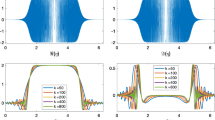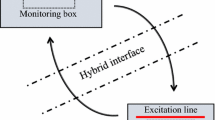Abstract
We consider the scattering of time-harmonic acoustic waves at objects composed of several homogeneous parts with different material properties. In Claeys (A single trace integral formulation of the second kind for acoustic scattering, 2011), a novel second-kind boundary integral formulation for this scattering problem was proposed, that relies on skeleton Cauchy data as unknowns. We recast it into a variational problem set in \(L^{2}\) and investigate its Galerkin boundary element discretization from a theoretical and algorithmic point of view. Empiric studies demonstrate the competitive accuracy and superior conditioning of the new approach compared to a widely used Galerkin boundary element approach based on a first-kind boundary integral formulation.







Similar content being viewed by others
Notes
Capital letters are used to refer to functions defined over a volume domain.
Notations for function spaces (Sobolev spaces) follow the usual conventions, see [7, 17]. In particular, we write \(H_\mathrm{{loc}}^{s}({{\mathbb {R}}^{d}})\) for functions that belong to \(H^{s}(K)\) for any compact subset \(K\) of \({\mathbb {R}}^{d}\), see [21, Definition 2.6.1]. \(H_\mathrm{{comp}}^{s}({\Omega })\) contains all distributions in \(H_\mathrm{{loc}}^{s}({\Omega })\) that have compact support in \(\Omega \), see [21, Definition 2.6.5].
\(H_\mathrm{{loc}}^{1}({\Delta ,\overline{\Omega }}):=\{U\in H_\mathrm{{loc}}^{1}({\overline{\Omega }})\,|\, \Delta U \in L_\mathrm{{comp}}^{2}({\overline{\Omega }}) \}\), see [21, Equation (2.108)].
Fraktur font is used to designate functions in the Cauchy trace space, whereas Roman typeface is reserved for Dirichlet traces, and Greek symbols for Neumann traces.
References
Digital library of mathematical functions. http://dlmf.nist.gov/. Accessed 29 August 2011
NGSolve finite element library. http://sourceforge.net/apps/mediawiki/ngsolve. Accessed 02 May 2012
Abramowitz, M., Stegun, I.A.: Handbook of mathematical functions with formulas, graphs, and mathematical tables, vol. 55. Dover publications, New York (1964)
Ball, J.M., Capdeboscq, Y., Tsering Xiao, B.: On uniqueness for time harmonic anisotropic Maxwell’s equations with piecewise regular coefficients. Math. Models Meth. Appl. Sci. arXiv:1201.2006v1 [math.AP] (2012)
Barnett, A., Greengard, L.: A new integral representation for quasi-periodic scattering problems in two dimensions. BIT Numer. Math. 51(1), 67–90 (2011)
Claeys, X.: A single trace integral formulation of the second kind for acoustic scattering. Research Report 2011–14, Seminar for Applied Mathematics, ETH Zürich (2011)
Claeys, X., Hiptmair, R., Jerez-Hanckes, C.: Multitrace boundary integral equations. In: Graham, I.G., Langer, U., Melenk, J.M., Sini, M. (eds.) Direct and inverse problems in wave propagation and applications. Radon series on computational and applied mathematics, vol. 14, pp. 51–100. De Gruyter, Berlin/Boston (2013)
Colton, D., Kress, R.: Inverse acoustic and electromagnetic scattering theory. Applied Mathematical Sciences, vol. 93, 2nd edn. Springer, Heidelberg (1998)
Costabel, M.: Boundary integral operators on Lipschitz domains: elementary results. SIAM J. Math. Anal. 19, 613 (1988)
Costabel, M., Stephan, E.P.: A direct boundary equation method for transmission problems. J. Math. Anal. Appl. 106, 367–413 (1985)
Greengard, L., Lee, J.Y.: Short note: Stable and accurate integral equation methods for scattering problems with multiple material interfaces in two dimensions. J. Comput. Phys. 231(6), 2389–2395 (2012)
Harrington, R.F.: Boundary integral formulations for homogeneous material bodies. J. Electromagn. Waves Appl. 3(1), 1–15 (1989)
Hazard, C., Lenoir, M.: On the solution of time-harmonic scattering problems for Maxwell’s equations. SIAM J. Math. Anal. 27(6), 1597–1630 (1996)
Hsiao, G.C., Wendland, W.L.: Boundary integral equations. Springer, Berlin Heidelberg (2008)
Hohage, T., Nannen, L.: Hardy space infinite elements for scattering and resonance problems. SIAM J. Numer. Anal. 47(2), 972–996 (2009)
Kress, R., Roach, G.F.: Transmission problems for the Helmholtz equation. J. Math. Phys. 19(6), 1433–1437 (1978)
McLean, W.: Strongly elliptic systems and boundary integral equations. Cambridge University Press, Cambridge, UK (2000)
Müller, C.: Foundations of the mathematical theory of electromagnetic waves. Springer, Berlin, Heidelberg, New York (1969)
Poggio, A.J., Miller, E.K.: Integral equation solution of three-dimensional scattering problems. In: Mittra, R. (ed.) Computer techniques for electromagnetics, chapter 4, pp. 159–263. Pergamon, New York (1973)
Rokhlin, V.: Solution of acoustic scattering problems by means of second kind integral equations. Wave Motion 5(3), 257–272 (1983)
Sauter, S.A., Schwab, C.: Boundary element methods. Springer, Berlin (2011)
Schwab, C.: Variable order composite quadrature of singular and nearly singular integrals. Computing 53(2), 173–194 (1994)
Steinbach, O.: Numerical approximation methods for elliptic boundary value problems: finite and boundary elements. Springer, Berlin (2008)
Von Petersdorff, T.: Boundary integral equations for mixed Dirichlet, Neumann and transmission problems. Math. Methods Appl. Sci. 11(2), 185–213 (1989)
Wang, M., Engström, C., Schmidt, K., Hafner, C.: On high-order FEM applied to canonical scattering problems in plasmonics. J. Comput. Theor. Nanosci. 8, 1–9 (2011)
Author information
Authors and Affiliations
Corresponding author
Additional information
Communicated by Ulrich Langer.
The work of E. Spindler was partially supported by SNF under grant 20021_137873/1.
Rights and permissions
About this article
Cite this article
Claeys, X., Hiptmair, R. & Spindler, E. A second-kind Galerkin boundary element method for scattering at composite objects. Bit Numer Math 55, 33–57 (2015). https://doi.org/10.1007/s10543-014-0496-y
Received:
Accepted:
Published:
Issue Date:
DOI: https://doi.org/10.1007/s10543-014-0496-y




